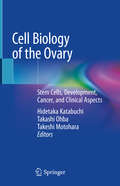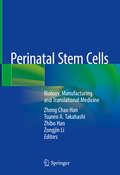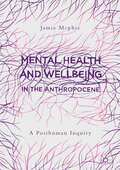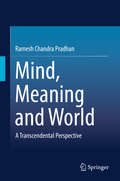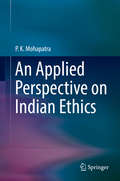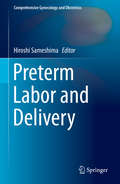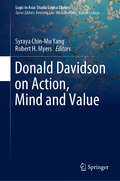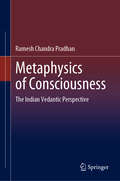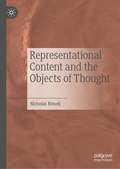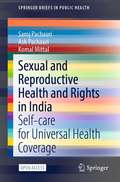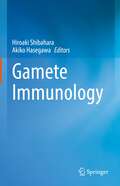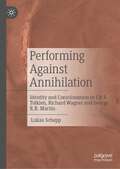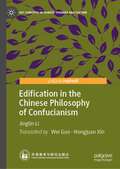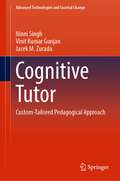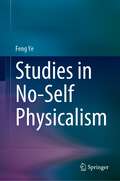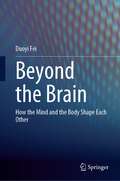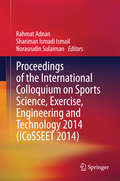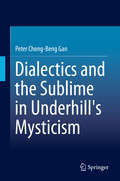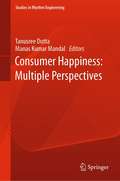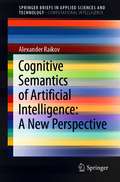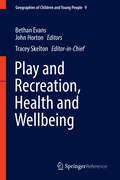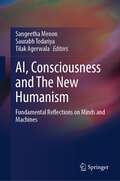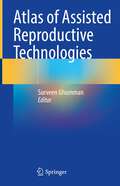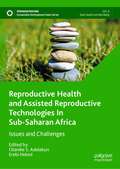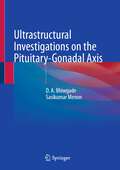- Table View
- List View
Cell Biology of the Ovary: Stem Cells, Development, Cancer, And Clinical Aspects
by Takeshi Motohara Takashi Ohba Hidetaka KatabuchiThis unique compilation focuses on a very curious organ, the ovary. There are still many unknown facts about the origins of ovarian tissue and ovarian cancer, and each chapter describes in detail the latest insights into the ovary from basic to clinical aspects. Expert authors reveal the most recent findings on ovariogenesis and ovarian carcinogenesis by shedding light on stem cell biology for the ovarian surface epithelial cells or primordial germ cells. Readers will greatly increase their understanding of the relevance of the cells that constitute the ovary, which is of vast significance in comprehending the occurrence mechanism of ovarian tissue and ovarian cancer. In this way the book covers a wide range of fields concerned with the ovary. This work benefits not only gynecologists and obstetricians, but also basic researchers in the field of stem cell biology and all clinicians who are involved in the management of fertility preservation or ovarian cancer.
Perinatal Stem Cells: Biology, Manufacturing and Translational Medicine
by Zhong Chao Han Tsuneo A. Takahashi Zhibo Han Zongjin LiThis book provides a comprehensive introduction to various types of perinatal stem cells. Given their unique regenerative abilities, stem cells offer a promising avenue in the treatment of degenerative diseases or injury. Currently, the limitations of postnatal cell sources and expanding efficiency may limit autologous stem cell therapies. Although embryonic stem cells (ESCs) and induced pluripotent stem cells (iPSCs) can be cultured indefinitely ex vivo, and can differentiate into three germ layers, ethical issues, the teratoma formation of ESCs and oncogenic risk of iPSCs are major obstacles to their clinical application. More recently, perinatal stem cells have been isolated from the umbilical cord, Wharton’s Jelly, placenta, amniotic membrane and amniotic fluid, which are normally discarded as medical waste. This book, after describing perinatal stem cells in detail, introduces readers to the various types of perinatal stem cells, addressing their characterization, banking, quality control and stability. Importantly, it also reviews the clinical applications of perinatal stem cells to therapy of diseases. Accordingly, it offers a valuable resource for clinicians, researchers and graduate students alike.
Mental Health and Wellbeing in the Anthropocene: A Posthuman Inquiry
by Jamie McphieThis book makes the unorthodox claim that there is no such thing as mental health. It also deglamourises nature-based psychotherapies, deconstructs therapeutic landscapes and redefines mental health and wellbeing as an ecological process distributed in the environment – rather than a psychological manifestation trapped within the mind of a human subject. Traditional and contemporary philosophies are merged with new science of the mind as each chapter progressively examples a posthuman account of mental health as physically dispersed amongst things – emoji, photos, tattoos, graffiti, cities, mountains – in this precarious time labelled the Anthropocene. Utilising experimental walks, play scripts and creative research techniques, this book disrupts traditional notions of the subjective self, resulting in an Extended Body Hypothesis – a pathway for alternative narratives of human-environment relations to flourish more ethically. This transdisciplinary inquiry will appeal to anyone interested in non-classificatory accounts of mental health, particularly concerning areas of social and environmental equity – post-nature.
Mind, Meaning and World: A Transcendental Perspective
by Ramesh Chandra PradhanThe present book intends to approach the problem of mind, meaning and consciousness from a non-naturalist or transcendental point of view. The naturalization of consciousness has reached a dead-end. There can be no proper solution to the problem of mind within the naturalist framework. This work intends to reverse this trend and bring back the long neglected transcendental theory laid down by Kant and Husserl in the West and Vedanta and Buddhism in India. The novelty of this approach lies in how we can make an autonomous space for mind and meaning without denying its connection with the world. The transcendental theory does not disown the embodied nature of consciousness, but goes beyond the body in search of higher meanings and values. The scope of this work extends from mind and consciousness to the world and brings the world into the space of mind and meaning with a hope to enchant the world. The world needs to be retrieved from the stranglehold of scientism and naturalism. This book will dispel the illusion about naturalism which has gripped the minds of our generation. The researchers interested in the philosophy of mind and consciousness can benefit from this work.
An Applied Perspective on Indian Ethics
by P. K. MohapatraThis book presents a novel interpretation of major problems of Indian ethics from an applied ethical perspective. It approaches prominent theories like Dharma, Karma and Purusarthas from a critical point of view, so as to render them logically consistent and free from some standard limitations. Ethical theories are meant to provide guidance for life, but quite often many of our celebrated theories appear to be inapplicable or difficult to apply in practical life. Indian ethical theories are of special significance to this problem because they have in them rich potentials of applicability as much as many of them typify inapplicable abstract theories of morals. The book incorporates a wealth of research on ethical theories, keeping in view the spirit of ethics and the demands of the situations; for a reasoned balance between the two is the key to applied ethics. The book argues that ethical theories are objective but defeasible in overriding circumstances where competing values deserve preference. Such justified exceptions are warranted by the very spirit of ethics, which is to promote the good life. The argument from defeasibility and justified violation in the book helps bridging the gap between ethics and its application and makes Indian theories of value appear in fresh light- workable, practically applicable and effective as incentives for morality. With uncommon virtue of contemporized presentation of Indian ethics, this book should be of interest to scholars and researchers working on Indian ethics and moral philosophy, as well as to those interested in Indian culture and value tradition.
Preterm Labor and Delivery (Comprehensive Gynecology and Obstetrics)
by Hiroshi SameshimaThis splendid volume presents numerous aspects of preterm labor and delivery, from its fundamental mechanism to clinically focused approaches. The incidence of preterm delivery is 6-7% in Japan, while globally up to 10% of pregnancies with preterm labor result in premature delivery. The rates of overall survival and intact survival of the premature infants are also excellent in Japan. Thus Japan’s approach to preterm labor and delivery has long attracted attention. In each chapter, experts describe specific issues unique to conditions in Japan, including diagnosis, tocolytic agents, definition of clinical chorioamnionitis, treatment of bacterial vaginosis, role of amniocentesis, management of preterm premature membrane rupture and also placental pathology, presenting definitive evidence of the reduced incidence of preterm delivery in Japan. This book benefits not only obstetricians, pediatricians and gynecologist, but also midwives, nurse practitioners, and medical and associated staffs in the field of obstetrics, pediatrics, as well as neonatal and perinatal medicine who are involved in delivery.
Donald Davidson on Action, Mind and Value (Logic in Asia: Studia Logica Library)
by Syraya Chin-Mu Yang Robert H. MyersThis book brings together a wide range of innovative reflections on the pivotal role that Davidson’s concept of agency plays in his later philosophy and its impact on his epistemology, his philosophy of language and mind, and his philosophy of values. The authors critically assess central elements of Davidson’s program and offer reappraisals of his seminal contributions to, and his continuing influence on, the development of contemporary philosophy. By focusing on agency, the book reveals Davidson’s views to have been more dynamic and less reductive than previously acknowledged – pointing toward important new possibilities not only in the theory of knowledge, but also in the philosophy of mind.It is a valuable resource both for experts on Davidson’s philosophy and for those interested in central topics in the theory of action, the philosophy of mind and language, epistemology, moral philosophy, and the philosophy of values. It is also of interest to researchers in adjoining disciplines, such as cognitive science, linguistics, and psychology.
Metaphysics of Consciousness: The Indian Vedantic Perspective
by Ramesh Chandra PradhanThis book explores the transition from the mind to the Supermind within the scope of an evolutionary metaphysics. The idea of Supermind has not been discussed so far in the mainstream philosophy of mind and consciousness. This book will give a new approach to the study of consciousness from the Indian vedantic perspective which has introduced the idea of Supermind, especially in the works of Sri Aurobindo. The book also undertakes a sustained critique of the contemporary theories of mind which have promoted mostly a mechanistic and naturalistic theory of mind and consciousness. The book is meant for the researchers who are engaged in the study of consciousness and for those who are interested in the philosophy of mind in general. This book will serve the purpose of the much-needed counter perspective to the contemporary theories of mind working broadly within the materialist traditions.
Representational Content and the Objects of Thought
by Nicholas RimellThis book defends a novel view of mental representation—of how, as thinkers, we represent the world as being. The book serves as a response to two problems in the philosophy of mind. One is the problem of first-personal, or egocentric, belief: how can we have truly first personal beliefs—beliefs in which we think about ourselves as ourselves—given that beliefs are supposed to be attitudes towards propositions and that propositions are supposed to have their truth values independent of a perspective? The other problem is how we can think about nonexistents (e.g., Santa Claus) given the widespread view that thought essentially involves a relation between a thinker and whatever is being thought about. The standard responses to this puzzle are either to deny that thought is essentially relational or to insist that it is possible to stand in relations to nonexistents. This book offers an error theory to the problem. The responses from this book arise from the same commitment: a commitment to treating talk of propositions—as the things towards which our beliefs are attitudes—as talk of entities that actually exist and that play a constitutive and explanatory role in the activity of thought.
Sexual and Reproductive Health and Rights in India: Self-care for Universal Health Coverage (SpringerBriefs in Public Health)
by Saroj Pachauri Ash Pachauri Komal MittalThis open access book addresses self-care on sexual and reproductive health and rights and HIV prevention and treatment in the most marginalized and vulnerable communities. Case studies and personal narratives are used to share their perspectives and experiences, sources of information for self-care products, motivations for self-care, and challenges and outcomes. Self-care provides the way to reach the last mile in achieving universal health coverage and the Sustainable Development Goals. Issues related to stigma, discrimination and violence among these communities are highlighted. Changes in policies and programs to improve their sexual and reproductive health, education and employment are discussed. The last chapter in the book examines how the agenda on self-care can be advanced in the years ahead. The audience for this publication includes health professionals, researchers, those managing health institutions and service providers.
Gamete Immunology
by Hiroaki Shibahara Akiko HasegawaThis book describes the biology, diagnosis, treatment and the latest research on anti-sperm antibody (ASA) and anti-zona pellucida antibody (AZPA) produced in some infertile patients. It summarizes ASA in both men and women, and presents new research to serve as a guideline for medical treatment, which currently varies considerably. It also discusses the recently identified target antigens of these antibodies, and the latest immunocontraceptive development projects. The book features chapters on AZPA explaining the biological structure and function of the zona pellucida, and describing the abnormality and the antibody. It also provides insights into their evolution, presenting the differences in taxonomy, mammalian physiological functions and the morphologically and immunologically unique human zona pellucida. Gamete Immunology is a valuable resource for researchers, and postdocs who are curious about new research on ASA and AZPA. It offers clinicians and embryologists who are interested in gamete immunology diverse perspectives as well as the basis for new ideas to treat the antibodies and develop contraceptive vaccinogens.
Performing Against Annihilation: Identity and Consciousness in J.R.R. Tolkien, Richard Wagner and George R.R. Martin
by Lukas ScheppThis book outlines how the protagonists in The Nibelung's Ring, The Lord of the Rings, and Game of Thrones attempt to construct identities and expand their consciousness manifestations. As the characters in the three works face the ends of their respective worlds, they must find answers to their mortality, and to the threat it implies: the loss of identity and consciousness. Moreover, it details how this process is depicted performatively. In a hands-on and interdisciplinary approach, this book seeks to unveil the underlying philosophical concepts of identity and consciousness in the three works as they are represented audio-visually on stage and screen. Through the use of many practical examples, this book offers both academic scholars and any interested readers a completely new perspective on three enduringly popular and interrelated works.
Edification in the Chinese Philosophy of Confucianism (Key Concepts in Chinese Thought and Culture)
by Jinglin LiThis pivot focuses on “the concept of edification” in a bid to systematically expound its connotative structure and logical evolution. It is divided into ten chapters, embracing various issues, such as human nature as the foundation of edification, the development of edification and cultivation, the evolution of edification and the resultant life based on ritual and music, the political orientation and ultimate care of edification, and the nurturing of social edification, in an effort to offer a panoramic view of the intellectual features of Confucianism, and consequently a profound reflection on the cultural consciousness of contemporary China. The book is expected to satisfy the needs for a better understanding of edification as a Confucian concept, and the conceptual features of Chinese philosophy, or rather, Confucianism.
Cognitive Tutor: Custom-Tailored Pedagogical Approach (Advanced Technologies and Societal Change)
by Ninni Singh Vinit Kumar Gunjan Jacek M. ZuradaThis book illustrates the design, development, and evaluation of personalized intelligent tutoring systems that emulate human cognitive intelligence by incorporating artificial intelligence. Artificial intelligence is an advanced field of research. It is particularly used in the field of education to increase the effectiveness of teaching and learning techniques. With the advancement of internet technology, there is a rapid growth in web based distance learning modality. This mode of learning is better known as the e-learning system. These systems present low intelligence because they offer a pre-identified learning frame to their learners. The advantage of these systems is to offer to learn anytime and anyplace without putting emphasis on a learner's needs, competency level, and previous knowledge. Every learner has different grasping levels, previous knowledge, and preferred mode of learning, and hence, the learning process of one individual may significantly vary from other individuals. This book provides a complete reference for students, researchers, and industry practitioners interested in keeping abreast of recent advancements in this field. It encompasses cognitive intelligence and artificial intelligence which are very important for deriving a roadmap for future research on intelligent systems.
Studies in No-Self Physicalism
by Feng YeThis book demonstrates how a radical version of physicalism (‘No-Self Physicalism’) can offer an internally coherent and comprehensive philosophical worldview. It first argues that a coherent physicalist should explicitly treat a cognitive subject merely as a physical thing and should not vaguely assume an amorphous or even soul-like subject or self. This approach forces the physicalist to re-examine traditional core philosophical notions such as truth, analyticity, modality, apriority because our traditional understandings of them appear to be predicated on a cognitive subject that is not literally just a physical thing.In turn, working on the assumption that a cognitive subject is itself completely physical, namely a neural network-based robot programmed by evolution (hence the term ‘No-Self’), the book proposes physicalistic theories on conceptual representation, truth, analyticity, modality, the nature of mathematics, epistemic justification, knowledge, apriority and intuition, as well as a physicalistic ontology. These are meant to show that this No-Self Physicalism, perhaps the most minimalistic and radical version of physicalism proposed to date, can accommodate many aspects that have traditionally interested philosophers. Given its refreshingly radical approach and painstakingly developed content, the book is of interest to anyone who is seeking a coherent philosophical worldview in this age of science.
Beyond the Brain: How the Mind and the Body Shape Each Other
by Duoyi FeiDifferent from traditional research on the mind-body problem often discussed from an epistemological viewpoint, which assumes that mental processes are internal to the person, this book demonstrates the crucial role of contextual relevance in the workings of the mind and illustrates how mind emerges from the individual's interactions with her physical, social, and cultural environments. It also develops the interpersonal and social aspects of embodied mind. The body that creates meaning is not only an emotional, kinesthetic, and aesthetically experiencing body; the body that creates meaning is a social body. It suggests that mind-body relations are not only achieved through the interaction between our own mind and body, but by other minds in our intersubjective interactions. It is related to epistemology, metaphysics, ethics, value theory, action theory, and the philosophies of mind, science, logic, and technology. The readership may include graduate and undergraduate students studying philosophy, law, political science, sociology, psychology, etc., educators, researchers, scholars, and anyone who shows an interest in philosophy.
Proceedings of the International Colloquium on Sports Science, Exercise, Engineering and Technology 2014 (ICoSSEET #2014)
by Rahmat Adnan Shariman Ismadi Ismail Norasrudin SulaimanThe proceeding is a collection of research papers presented at the International Colloquium on Sports Science, Exercise, Engineering and Technology (ICoSSEET2014), a conference dedicated to address the challenges in the areas of sports science, exercise, sports engineering and technology including other areas of sports, thereby presenting a consolidated view to the interested researchers in the aforesaid fields. The goal of this conference was to bring together researchers and practitioners from academia and industry to focus on the scope of the conference and establishing new collaborations in these areas. The topics of interest are as follows but are not limited to:1. Sports and Exercise Science * Sports Nutrition * Sports Biomechanics * Strength and Conditioning * Motor Learning and Control * Sports Psychology * Sports Coaching * Sports and Exercise Physiology * Sports Medicine and Athletic Trainer * Fitness and Wellness * Exercise Rehabilitation * Adapted Physical Activity / Disability Sport * Physical Education * Dance, Games and Play 2. Sports Engineering and Technology Application * Sports Equipment Mechanics * Athlete Analysis and Measurement * Instrumentation and Measurement in Sports * Fluid Dynamics in Sports * Computational Modeling in Sports 3. Sports Industry and Management * Sports Event * Sports Management * Sports Tourism * Sports Marketing * Sports Ethics and Law * Sports Sociology * Outdoor and Recreation Management * Inclusive Recreation * Leisure
Dialectics and the Sublime in Underhill's Mysticism
by Peter Chong-Beng GanThis book represents a study of Evelyn Underhill's premier work on mysticism, using Hegel's dialectics and Kant's theory of the sublime as interpretive tools. It especially focuses on two prominent features of Underhill's text: the description of the mystical life as one permeated by an intense love between the mystic and infinite reality, and the detailed delineation of stages of mystical development. Given these two features, the text lends itself to a construction of a valuable discourse predicated on dialecticism, sublimity, and mysticism. The book also articulates a number of insights into the content and nature of the writings of Christian mystics.
Consumer Happiness: Multiple Perspectives (Studies in Rhythm Engineering)
by Tanusree Dutta Manas Kumar MandalThis book helps quench the quest of knowledge of academicians, researchers, and others interested in developing a complete and critical understanding of consumer happiness. The relentless search of happiness by humans is sought in different ways. Scientific discussion on happiness for long was considered a forte of Philosophers. Other disciplines seldom delved into this. But today not only science but neuroscience, marketing, and other varied fields have started delving into it and have developed a keen interest. The book has been conceptualized on this line of thinking and thus divided into two parts. The first part is customized towards understanding various perspectives of happiness and the relative importance of knowing the same. The first chapter of this section is on the biological perspective of happiness. The second is titled ‘Behavioural perspective’. The third chapter is an attempt to elucidate the cultural perspective of the concept of happiness. The fourth is on the role of technology in inducing happiness. Fifth and sixth are on theories of happiness and measuring happiness, respectively. Knowledge about the different perspective and theories has a wide range of benefits. It informs us about how the brain works, interprets, and reacts. This theoretical understanding helps us to move beyond the trial and error methods towards a more scientific underpinning of adoption of measures that would generate long-lasting happiness in consumers.The second part of the book is dedicated toward understanding consumer happiness from a neuroscience perspective, i.e. keeping consumer happy. This segment has ten chapters. The first is on differentiating the concept of happiness from satisfaction. The second is on sensory marketing and happiness. The third deals with the store design and shelving of products to generate happiness. Fourth and fifth chapters relate to persuading the consumers. While the fourth chapter is on developing persuasive messages and the fifth is on subliminal messaging sixth chapter is on pricing and seventh on advertising. The eighth chapter highlights the role of emotions and the ninth is on the different factors that induce happiness in consumers. The last chapter is about raising some unanswered questions and food for thought for readers. Together the contents of the book make for a complete understanding of the concept of happiness and how it is shaping the world of marketing. Addressing the ‘what’ and ‘how’ of consumer happiness in the same book makes the book comprehensive.
Cognitive Semantics of Artificial Intelligence: A New Perspective (SpringerBriefs in Applied Sciences and Technology)
by Alexander RaikovThis book addresses the issue of cognitive semantics’ aspects that cannot be represented by traditional digital and logical means. The problem of creating cognitive semantics can be resolved in an indirect way. The electromagnetic waves, quantum fields, beam of light, chaos control, relativistic theory, cosmic string recognition, category theory, group theory, and so on can be used for this aim. Since the term artificial intelligence (AI) appeared, various versions of logic have been created; many heuristics for neural networks deep learning have been made; new nature-like algorithms have been suggested. At the same time, the initial digital, logical, and neural network principles of representation of knowledge in AI systems have not changed a lot. The researches of these aspects of cognitive semantics of AI are based on the author's convergent methodology, which provides the necessary conditions for purposeful and sustainable convergence of decision-making.
Play and Recreation, Health and Wellbeing
by Bethan Evans John Horton Tracey SkeltonGeographies of children and young people is a rapidly emerging sub-discipline within human geography. There is now a critical mass of established academic work, key names within academia, growing numbers of graduate students and expanding numbers of university level taught courses. There are also professional training programmes at national scales and in international contexts that work specifically with children and young people. In addition to a productive journal of Children's Geographies, there's a range of monographs, textbooks and edited collections focusing on children and young people published by all the major academic presses then there is a substantive body of work on younger people within human geography and active authors and researchers working within international contexts to warrant a specific Major Reference Work on children's and young people's geographies. The volumes and sections are structured by themes, which then reflect the broader geographical locations of the research.
AI, Consciousness and The New Humanism: Fundamental Reflections on Minds and Machines
by Sangeetha Menon Saurabh Todariya Tilak AgerwalaThis edited volume presents perspectives from computer science, information theory, neuroscience and brain imaging, aesthetics, social sciences, psychiatry, and philosophy to answer frontier questions related to artificial intelligence and human experience. Can a machine think, believe, aspire and be purposeful as a human? What is the place in the machine world for hope, meaning and transformative enlightenment that inspires human existence? How, or are, the minds of machines different from that of humans and other species? These questions are responded to along with questions in the intersection of health, intelligence and the brain. It highlights the place of consciousness by attempting to respond to questions with the help of fundamental reflections on human existence, its life-purposes and machine intelligence. The volume is a must-read for interdisciplinary and multidisciplinary researchers in humanities and social sciences and philosophy of science who wish to understand the future of AI and society.
Atlas of Assisted Reproductive Technologies
by Surveen GhummanThis atlas provides details of the procedures of assisted reproductive techniques. The science of in-vitro fertilization has made considerable advances and many general gynecologists are now specializing to become infertility experts. It covers embryology and clinical aspects with pictures. This atlas serves as a quick reference as most of the lab work requires pictures of oocytes, embryos and sperms to understand the various stages of the process. It is a comprehensive, updated practical guide on procedures in in-vitro fertilization helpful for general gynecologists and infertility experts.
Reproductive Health and Assisted Reproductive Technologies In Sub-Saharan Africa: Issues and Challenges (Sustainable Development Goals Series)
by Olanike S. Adelakun Erebi NdoniThis book focuses on reproductive health rights and assisted reproductive technologies (ART) in sub-Saharan Africa. Each chapter is connected to the other by focusing on different aspects of ART as a means of achieving conception.Topics such as regulation of ART practices, surrogacy and specific aspects of ART, which are gradually becoming acceptable but largely unregulated in Africa, promises to be of interest to scholars, researchers and fertility practitioners. Research in the book take a rights based approach and ethical analysis of ART practice in sub-Saharan Africa by authors from diverse backgrounds bringing together law and society perspectives.Readers stand to gain new knowledge on the societal, legal, medical and psychological requirements, effects and challenges of reproductive health rights and ART in the African context. The book is also relevant to UN Sustainable Development Goal 3: Good Health and Well-being, given that it promotes and advocates for access to reproductive healthcare for persons who have difficulty or are unable to conceive without medical assistance.
Ultrastructural Investigations on the Pituitary-Gonadal Axis
by D. A. Bhiwgade Sasikumar MenonThis book provides the ultrastructural study of the pituitary–gonadal axis through the electron microscope. It is a compilation of extensive work carried out by Dr. D.A. Bhiwgade and his researchers over the last four decades. It explains the ultrastructural characteristics of pituitary cells in different morphological states and provides a comprehensive approach to identifying the structural and functional distinctions between various pituitary cell types. The book includes ultrastructural evaluations of the testis and epididymis after different experimental interventions to study the physiological correlations of the organs with spermatogenesis and the consequent structural deformities in sperm. An extensive section of different types of placentae is added for understanding the varied interactions of fetal and maternal tissues in the placental barrier. Placental types seen in bats, shrews, rodents, and monkeys are explained at the ultrastructural level to distinguish the tissue interrelationships within different placental layers. Detailed sketches have been provided to illustrate the correlations between the maternal and fetal tissues in different placental types for better understanding. This book is a ready reckoner and offers guidance to researchers and clinicians in understanding the cellular architecture and intracellular changes associated with various physiological states and clinical conditions of the pituitary, testis, epididymis, and placenta. This book offers assistance to all those using electron microscopy to evaluate cellular and tissue systems.
